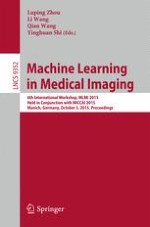2015 | Buch
Machine Learning in Medical Imaging
6th International Workshop, MLMI 2015, Held in Conjunction with MICCAI 2015, Munich, Germany, October 5, 2015, Proceedings
herausgegeben von: Luping Zhou, Li Wang, Qian Wang, Yinghuan Shi
Verlag: Springer International Publishing
Buchreihe : Lecture Notes in Computer Science
